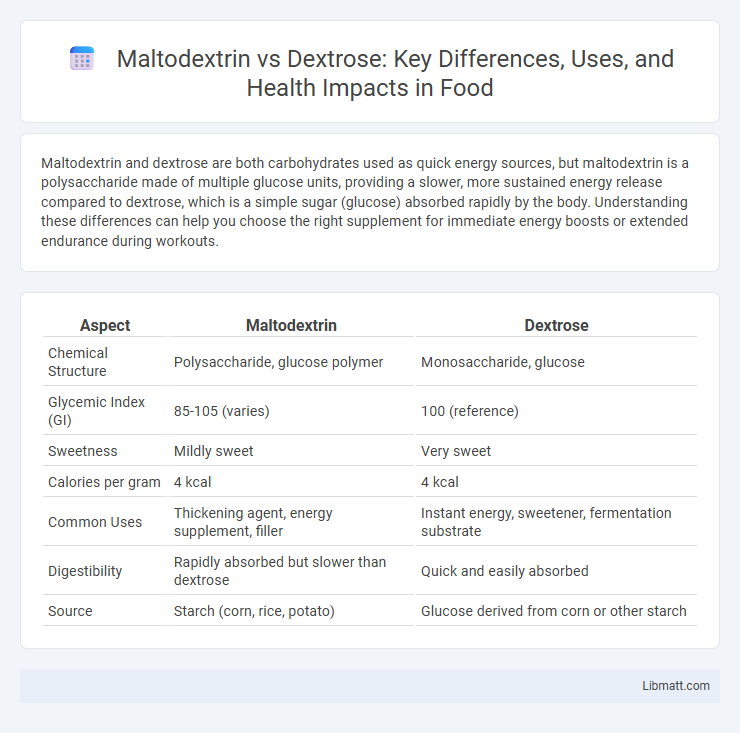Maltodextrin and dextrose are both carbohydrates used as quick energy sources, but maltodextrin is a polysaccharide made of multiple glucose units, providing a slower, more sustained energy release compared to dextrose, which is a simple sugar (glucose) absorbed rapidly by the body. Understanding these differences can help you choose the right supplement for immediate energy boosts or extended endurance during workouts.
Table of Comparison
| Aspect | Maltodextrin | Dextrose |
|---|---|---|
| Chemical Structure | Polysaccharide, glucose polymer | Monosaccharide, glucose |
| Glycemic Index (GI) | 85-105 (varies) | 100 (reference) |
| Sweetness | Mildly sweet | Very sweet |
| Calories per gram | 4 kcal | 4 kcal |
| Common Uses | Thickening agent, energy supplement, filler | Instant energy, sweetener, fermentation substrate |
| Digestibility | Rapidly absorbed but slower than dextrose | Quick and easily absorbed |
| Source | Starch (corn, rice, potato) | Glucose derived from corn or other starch |
Introduction to Maltodextrin and Dextrose
Maltodextrin and dextrose are both carbohydrate-based food additives derived from starch, commonly used in sports nutrition and food manufacturing. Maltodextrin is a polysaccharide with a high glycemic index, providing quick energy by breaking down slowly compared to dextrose, a simple sugar (glucose) that is rapidly absorbed for immediate replenishment. Understanding the differences in their absorption rates and effects on blood sugar can help you choose the best carbohydrate source for energy needs or recovery.
Chemical Structure Comparison
Maltodextrin and dextrose differ primarily in their chemical structures; maltodextrin is a polysaccharide composed of glucose units linked together, while dextrose is a simple monosaccharide, also known as glucose. The longer chains in maltodextrin result in slower digestion and a more gradual release of energy compared to the rapid absorption of dextrose. Understanding these structural differences can help you choose the right carbohydrate source for energy needs and digestion rates.
Sources and Production Methods
Maltodextrin is typically derived from starch sources such as corn, rice, potato, or wheat through partial hydrolysis, breaking down complex carbohydrates into shorter chains. Dextrose, also known as glucose, is produced by enzymatically hydrolyzing starch specifically into single glucose molecules, commonly sourced from corn or wheat. Understanding the differences in your choice between maltodextrin and dextrose can help tailor its use in food products or sports supplements based on desired absorption rates and sweetness.
Taste and Texture Differences
Maltodextrin has a mildly sweet to neutral taste and a powdery, smooth texture, making it ideal for thickening and bulking without overpowering flavors. Dextrose, a simple sugar derived from glucose, offers a distinctly sweet taste and dissolves quickly, contributing to a syrupy texture in liquids. These differences influence their use in food products, with maltodextrin preferred for subtle sweetness and texture control, while dextrose enhances sweetness and rapid energy release.
Glycemic Index and Blood Sugar Impact
Maltodextrin has a high glycemic index (GI) ranging between 85 to 105, causing rapid spikes in blood sugar levels similar to pure glucose. Dextrose, a form of glucose, has a GI of 100, reflecting its immediate impact on elevating blood sugar. Both carbohydrates lead to quick increases in blood glucose, making them important considerations for glycemic control and insulin response in diabetic or insulin-sensitive individuals.
Uses in Food and Beverage Industries
Maltodextrin and dextrose are widely used in the food and beverage industries for their functional properties; maltodextrin serves as a thickener, filler, and stabilizer in products like sauces, snacks, and sports drinks, enhancing texture and mouthfeel without adding sweetness. Dextrose, a simple sugar derived from corn, is primarily used as a sweetener and fermentable carbohydrate in baked goods, beverages, and confectionery, providing rapid energy and promoting browning through Maillard reactions. Your choice between maltodextrin and dextrose depends on whether you need bulk and texture modification or quick sweetness and fermentability in your formulation.
Applications in Sports and Fitness Nutrition
Maltodextrin and dextrose serve distinct roles in sports and fitness nutrition, with maltodextrin favored for sustained energy release during prolonged exercise due to its complex carbohydrate structure. Dextrose, a simple sugar, is rapidly absorbed and primarily used for quick glycogen replenishment immediately after intense workouts. Athletes often combine these carbs for optimized performance and recovery, leveraging maltodextrin for endurance and dextrose for rapid energy restoration.
Health Considerations and Potential Side Effects
Maltodextrin and dextrose are both fast-digesting carbohydrates, but maltodextrin has a higher glycemic index, potentially causing more rapid blood sugar spikes and insulin response. Dextrose, being pure glucose, may be easier to metabolize but can still lead to similar issues in individuals with insulin sensitivity or diabetes. Both substances can contribute to digestive discomfort, such as bloating or gas, when consumed in large quantities or by those with gastrointestinal sensitivities.
Suitability for Special Diets
Maltodextrin and dextrose differ in suitability for special diets due to their glycemic impact and source. Maltodextrin, a polysaccharide derived from starch, has a moderate glycemic index and is often used in gluten-free and hypoallergenic products but may not be ideal for ketogenic or low-carb diets. Dextrose, a simple glucose sugar with a high glycemic index, is less suitable for diabetic or low-sugar diets but provides quick energy in clinical nutrition and sports supplements.
Choosing Between Maltodextrin and Dextrose
Choosing between maltodextrin and dextrose depends on your specific energy needs and digestion rate. Maltodextrin has a higher glycemic index and is absorbed more slowly than dextrose, making it ideal for sustained energy release during endurance activities. Dextrose offers rapid absorption and quick blood sugar spikes, suitable for immediate energy replenishment post-exercise.
Maltodextrin vs Dextrose Infographic

 libmatt.com
libmatt.com